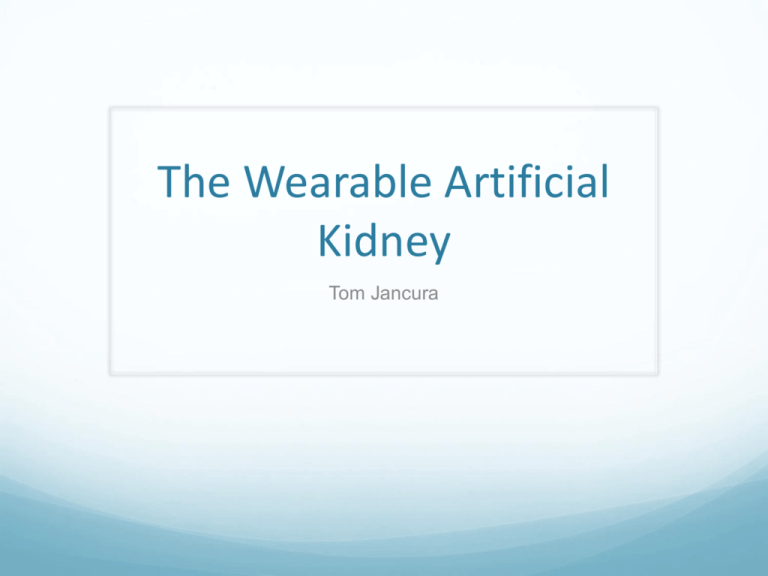The Wearable Artificial Kidney
advertisement

The Wearable Artificial Kidney Tom Jancura What is Dialysis 2 Types of dialysis Hemodialysis-uses a machine to filter the blood Peritoneal- Uses the lining of abdomen to filter blood Filters the blood of toxins, and waste products Used when a patient is waiting for a kidney transfer or just not getting a transfer. What is it? • Being developed in Washington by Dr. Victor Gura • Way for patients to receive dialysis treatment and still live and everyday life • A 10 lb belt that goes around the patients waist with multiple components to help with the dialysis Problem Being Solved • This device is to help treat patients with end stage renal failure (kidney failure) • This means their Kidneys can not filter the waste products from their blood • This can be caused by diabetes, high blood pressure, or other diseases • If not treated can lead to increased acid levels, raised potassium levels, decreased calcium levels, increased levels of phosphate, and in later stages anemia Current Technology The Artificial Kidney Will make patients lives easier for dialysis treatment Will lower the mortality rate for chronic kidney disease Attached to the body through a catheter which will take the blood from the body and filter the waste and replenish the nutrients that are vital for the human body. Will use less water and not have to be distilled because water can be recycled through the filtration devices on the belt Results The Artificial Kidney has been approved for clinical trials in the US Although trials of the kidney have already been conducted in Europe The trial will last at least 24 hours and the goal is for 10 patients to last the full length of the trial Successful trials have been completed in Europe ( in Vicenza, Italy and London) Trials were completed successfully in Italy for 6 hours and in London for 8 hours. Current Trials Trials are being held in Seattle Washington, and trying to get the device approved by the FDA for patient use Patients go through a normal dialysis treatment Then go through their clinical trial of 24 hours just on the wearable artificial kidney Closely monitored by Dr. Victor Gura (head of research) and his team of researchers in case of malfunction Limitations Must be worn at all times Powered by a battery, so the need for battery change/ charging Worn around the waist and could get in the way The device is 10 pounds hanging from the waist Unknown cost because still in design and trials Future • Make the belt smaller and more compact • Make the belt lighter and more convenient for older patients • Possible Design changes to become more efficient • Pass clinical trials and be put to use for actual patient care Resources http://www.nlm.nih.gov/medlineplus/dialysis.html Victor Gura, Claudio Ronco, Andrew Davenport. The Wearable Artificial Kidney, Why and How: From Holy Grail to Reality. Seminars in Dialysis. Volume 22. Issue 1. pp 13-17. January 2009. http://hsnewsbeat.uw.edu/story/faq-seattle-wearable-artificial-kidneysafety-trial https://www.kidney.org/kidneydisease/aboutckd http://www.medscape.com/viewarticle/583426 http://www.bizjournals.com/seattle/blog/health-careinc/2014/09/wearable-tech-goes-to-the-doctor-uw-to-test.html






